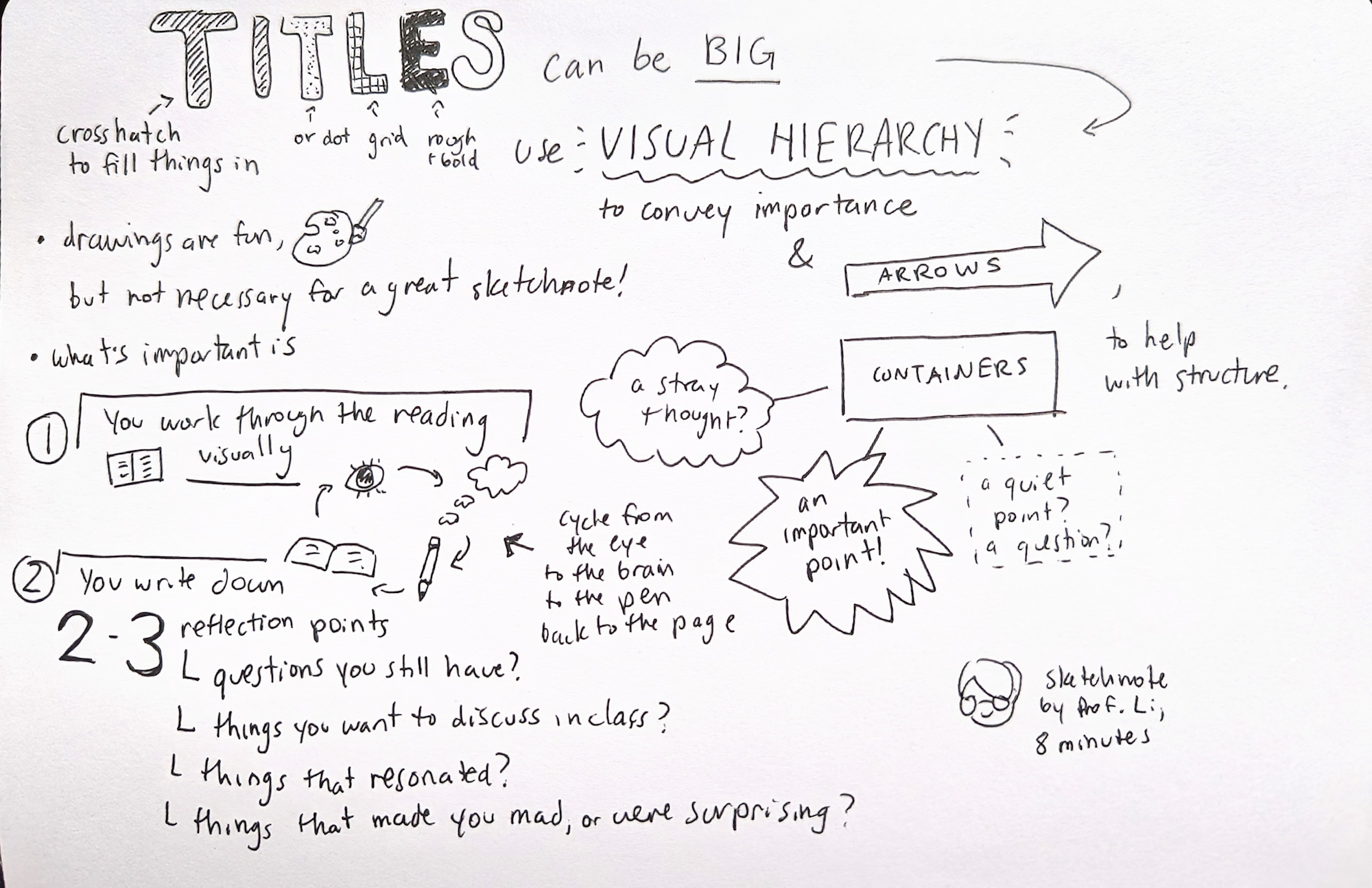Why sketchnote?
A sketchnote is a form of visual note taking, combining text, layout, imagery, and, optionally, color. To sketch is to think. The main advantages of sketchnoting versus traditional note taking is higher retention and comprehension, and practicing drawing ideas will serve you well in your career.
In addition to showing you read the material, each sketchnote should include 2-3 reflection points. What questions do you have? What in the reading was surprising, or resonated?
Materials
All you need is paper (or a whiteboard) and something to write with! As you get more comfortable with sketchnoting, try experimenting with different colored highlighters or markers–but a lot can be accomplished with a single pen, such as:

Scan or take a clear photo of your sketchnotes to submit them on Canvas. If you’re an iPhone user, Apple Notes has a good built in scanning feature. Otherwise, I also recommend Adobe Scan. Sometimes just taking a photo with your camera and adjusting the white point works just fine (that’s what I did for the image above). The main thing to focus on is having good lighting for clear readability–if I can’t read it, I can’t grade it!
If you prefer digital notetaking, you can try Goodnotes or Notability. Both are free to use but are subscription models (which, to soap box, I hate.) Procreate, an iPad drawing app, and a great pixel-based alternative with a one-time payment. In terms of websites, I like tldraw.
Resources
- YouTube video: How to Sketchnote without Drawing
- This video highlights how you can create a great sketchnote just with text, lines, and containers.
- Book: The Doodle Revolution by Sunni Brown.
- About the importance of visual languages and includes concrete tips and activities to hone your doodling skills.
- TEDx talk: Drawing in Class
- About the cognitive and learning benefits of drawing quick imagery to take notes, such as being able to decide what the key points are.
Examples and expectations
You will certainly get faster at taking sketchnotes as the semester goes on, but to start out, try not to spend more than an hour per sketchnote. I would recommend taking them as you read materials, and then quickly go back and emphasizing specific points once you finish the entire reading. There are a few examples from past students uploaded to Canvas (to preserve student privacy).
Skimming the middle details (such as related work, or implementation details) of the reading is OK: knowing, and sketchnoting, the core argument is what’s important. You should always fully read a paper’s introduction and conclusion. The subheadings of a paper are helpful guides to how to establish the visual hiearchy of your sketchnote. I expect a sketchnote + reading to take no more than 90 minutes to begin with (for a ~15 page paper), but as the semester progresses, try to get it down to 60 minutes.
Rubric
- ✓+ : Sketchnote conveys you did the reading, includes reflections, and is visually stunning
- ✓ : Sketchnote conveys you did the reading, includes reflections, and has elements of visual thinking, such as including hierachy, layout, drawings
- ✓- : Sketchnote conveys you did the reading but lacks elements of visual thinking and/or missing reflections
- - : Sketchnote unreadable, does not fully convey you did the reading, and/or orientation of image/PDF not correctly uploaded